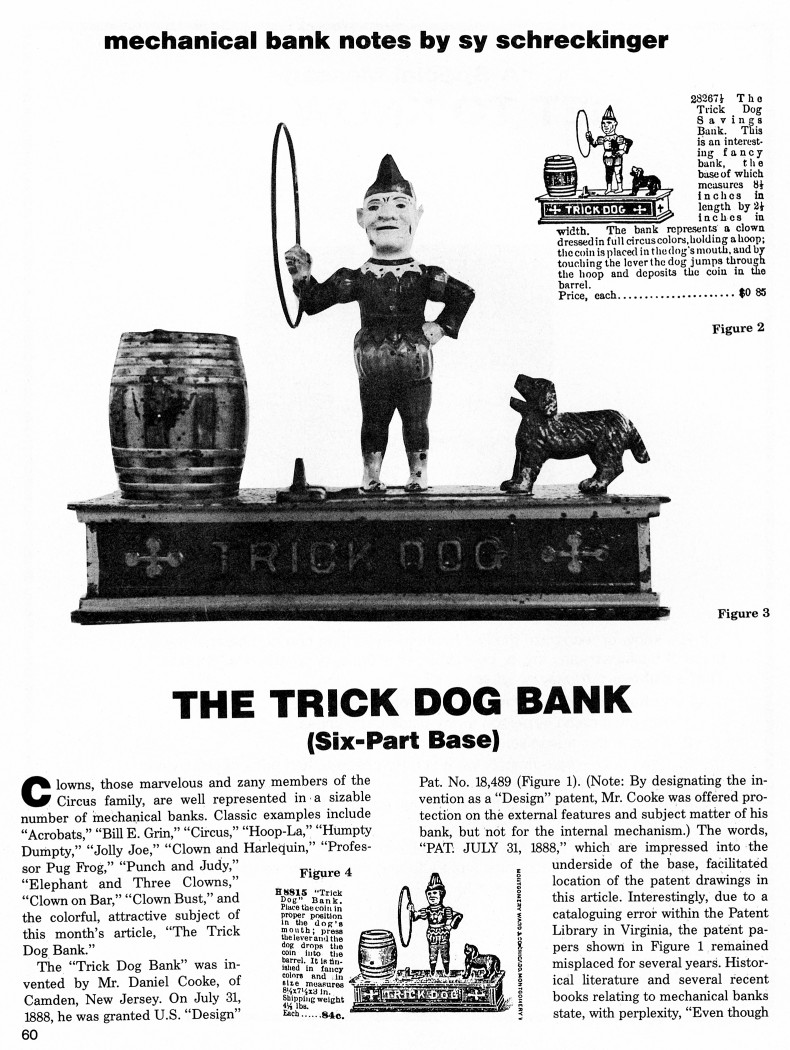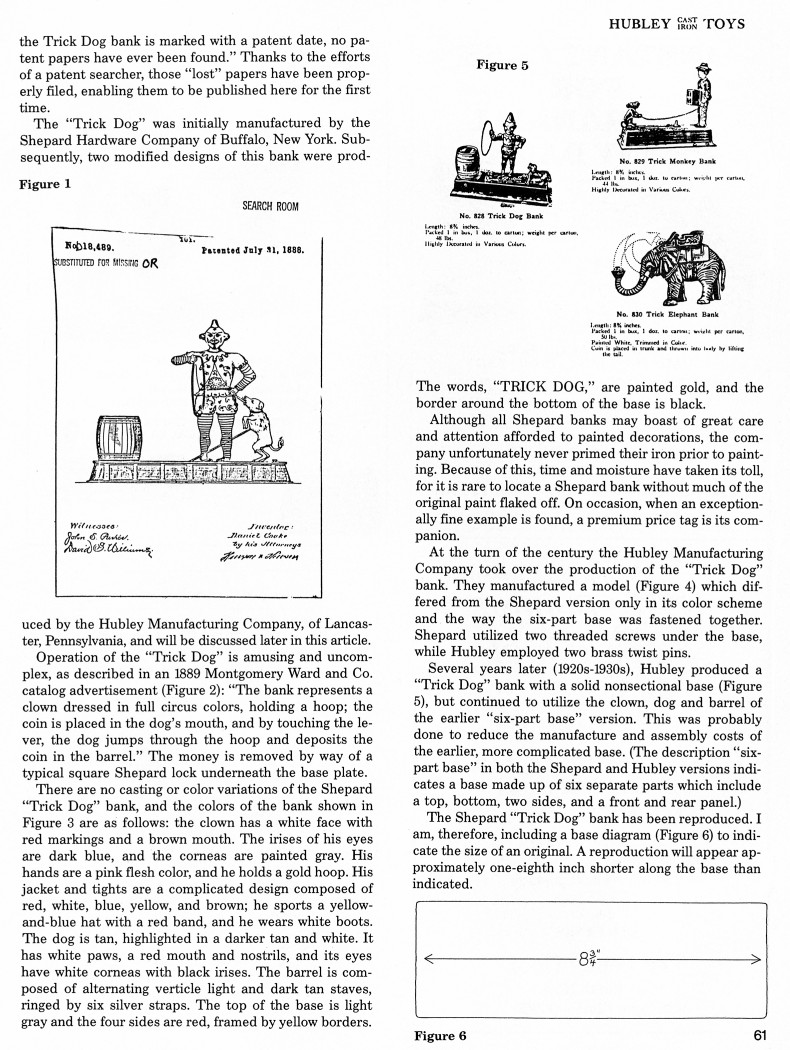|
The Trick Dog Bank
(Six Part Base)
by Sy Schreckinger – ANTIQUE TOY WORLD Magazine – November, 1988
Clowns, those marvelous and zany members of the
Circus family, are well represented in a sizable number of mechanical
banks. Classic examples include "Acrobats," "Bill E. Grin," "Circus,"
"Hoop-La," "Humpty Dumpty," "Jolly Joe," "Clown and Harlequin," "Professor
Pug Frog," "Punch and Judy," "Elephant and Three Clowns," "Clown on Bar,"
"Clown Bust," and the colorful, attractive subject of this month's
article, "The Trick Dog Bank."
The "Trick Dog Bank" was invented by Mr. Daniel Cooke, of Camden,
New Jersey. On July 31, 1888, he was granted U.S. "Design" Pat. No.
18,489
(Figure 1). (Note: By designating the invention as a "Design" patent, Mr.
Cooke was offered protection on the external features and subject matter
of his bank, but not for the internal mechanism.) The words, "PAT. JULY
31, 1888," which are impressed into the underside of the base, facilitated
location of the patent drawings in this article. Interestingly, due to a
cataloguing error within the Patent Library in Virginia, the patent papers
shown in Figure 1 remained misplaced for several years. Historical
literature and several recent books relating to mechanical banks state,
with perplexity, "Even though the Trick Dog bank is marked with a patent
date, no patent papers have ever been found." Thanks to the efforts of a
patent searcher, those "lost" papers have been properly filed, enabling
them to be published here for the first time.
The "Trick Dog" was
initially manufactured by the Shepard Hardware Company of Buffalo, New
York. Subsequently, two modified designs of this bank were produced by the Hubley Manufacturing Company, of Lancaster, Pennsylvania, and will be
discussed later in this article.
Operation of the "Trick Dog" is amusing and uncomplex, as described
in an 1889 Montgomery Ward and Co. catalog advertisement (Figure 2): "The
bank represents a clown dressed in full circus colors, holding a hoop; the
coin is placed in the dog's mouth, and by touching the lever, the dog
jumps through the hoop and deposits the coin in the barrel." The money is
removed by way of a typical square Shepard lock underneath the base plate.
There are no casting or color variations of the Shepard "Trick Dog"
bank, and the colors of the bank shown in Figure 3 are as follows: the
clown has a white face with red markings and a brown mouth. The irises of
his eyes are dark blue, and the corneas are painted gray. His hands are a
pink flesh color, and he holds a gold hoop. His jacket and tights are a
complicated design composed of red, white, blue, yellow, and brown; he
sports a yellow and blue hat with a red band, and he wears white boots.
The dog is tan, highlighted in a darker tan and white. It has white paws,
a red mouth and nostrils, and its eyes have white corneas with black
irises. The barrel is composed of alternating vertical light and dark tan
staves, ringed by six silver straps. The top of the base is light gray and
the four sides are red, framed by yellow borders. The words, "TRICK DOG,"
are painted gold, and the border around the bottom of the base is black.
Although all Shepard banks may boast of great care and attention
afforded to painted decorations, the company unfortunately never primed
their iron prior to painting. Because of this, time and moisture have
taken its toll, for it is rare to locate a Shepard bank without much of
the original paint flaked off. On occasion, when an exceptionally fine
example is found, a premium price tag is its companion.
At the turn of the century the Hubley Manufacturing Company took over
the production of the "Trick Dog" bank. They manufactured a model (Figure
4) which differed from the Shepard version only in its color scheme and
the way the six-part base was fastened together. Shepard utilized two
threaded screws under the base, while Hubley employed two brass twist
pins.
Several years later (1920s-1930s), Hubley produced a "Trick Dog" bank
with a solid nonsectional base (Figure 5), but continued to utilize the
clown, dog and barrel of the earlier "six-part base" version. This was
probably done to reduce the manufacture and assembly costs of the earlier,
more complicated base. (The description "six-part base" in both the
Shepard and Hubley versions indicates a base made up of six separate
parts which include a top, bottom, two sides, and a front and rear panel.)
The Shepard "Trick Dog" bank has been reproduced. I am, therefore,
including a base diagram (Figure 6) to indicate the size of an original.
A reproduction will appear approximately one-eighth inch shorter along
the base than indicated.
|


